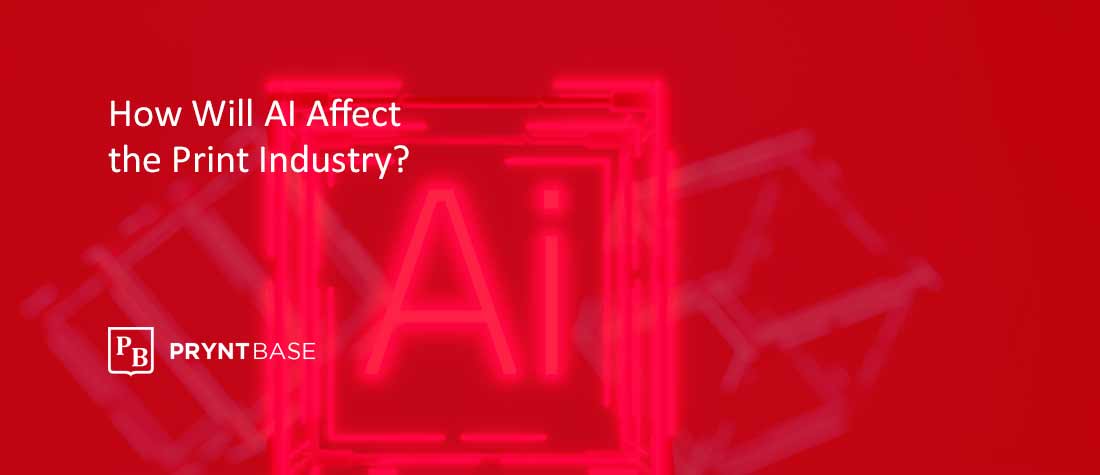How is AI Affecting the Print Industry?

The print industry, like many sectors, is not impervious to the transformative effects of Artificial Intelligence (AI). From design creation to prepress operations, from the standard printing process to sales strategies, AI is reshaping the way print companies operate.
To be honest while some people view this as disruption, we feel it’s more productive to welcome the changes, embrace the innovation, become more efficient and increase results.
In this article, we’ll delve into the multifaceted impact AI has on the print industry.
How Designers are Using AI Tools in the Print & Design Process
AI has unlocked a big opportunity for graphic designers. It’s not that these tools will replace a designer, instead it can assist the designer in creating something quicker or to ideate in faster more efficient ways.
Automated Design Suggestions
Tools such as Adobe Sensei leverage AI to provide automatic design suggestions, enhancing creativity and streamlining the design process. For example, if a designer is working on a brochure, these AI tools can suggest layouts, color schemes, and even typography based on the content and context of the body of work.
Image Enhancement
AI can automatically enhance images, correcting colors, removing backgrounds, or even upscaling resolutions without losing quality. This has actually been around for a while, but with the new tools being developed this is getting better and faster.
Customized Designs
AI can help in producing customized designs for clients by analyzing consumer data. This ensures that the design resonates well with the target audience. Customizations like these go well beyond the design and focus more on the full composition.
AI Use in Prepress Operations
As you know, Prepress is a critical phase in the print process, and it involves preparing files for the actual printing process. AI’s introduction to this step has brought both benefits and considerations.
Automated Proofreading
AI algorithms can now spot errors in layout, graphics, or text, ensuring that the final print is free of mistakes.
Color Correction
AI can predict how colors will appear post-printing and adjust them in the prepress stage to ensure consistency and accuracy.
File Optimization
AI can automatically optimize files for the print format, ensuring the highest quality output.
Trapping
One of the most important processes in prepress is trapping to ensure there isn’t unnecessary overlap or other issues that will affect registration. AI can assist in ensuring everything is aligned perfectly.
AI Prepress Considerations
While AI can streamline many prepress tasks, it’s crucial to remember that human oversight remains vital. AI tools can occasionally misinterpret design nuances, so having a human in the loop ensures quality control.
AI in Normal Print Process Operations
Getting away from the design aspect is how AI is infiltrating the typical operations of a print company. Workflow, Quality, Fulfillment, Delivery and Maintenance are all areas that Artificial Intelligence is improving the print industry.
Predictive Maintenance
An example is how AI algorithms can predict when a machine part is about to fail by analyzing usage patterns and performance data. This minimizes downtime and ensures smooth operations.
Quality Assurance
Not that this is a new thing, but cameras coupled with AI can continuously monitor print runs, checking for defects or inconsistencies. If an anomaly is detected, the system can automatically make adjustments or alert operators.
Optimized Ink Usage
Another example is how AI can determine the exact amount of ink needed for each job, reducing waste and ensuring cost-effective operations.
Workflow Automation
AI can automatically route jobs to the most suitable printer available, considering factors like printer capabilities, job size, and current printer workload.
AI-Powered Sales Assistance for Print Companies
AI being used in sales is happening across every industry and the print industry will benefit from this significantly as well. There are a number of universal AI sales applications and then others that can work more specifically for print service providers.
Chatbots and Virtual Assistants
Many print companies now use AI-powered chatbots on their websites. These bots can answer queries, provide quotes, and even help customers design custom print jobs.
Customer Insights
AI can analyze customer data, like past orders and interactions, to predict future needs. This allows print companies to tailor their marketing efforts and even suggest new products or services.
Automated Follow-Ups
Post-sale, AI tools can send follow-up emails, request feedback, or suggest reorder times based on the product’s estimated lifespan.
Efficient Quote Generation
Instead of manual calculations, AI can instantly generate quotes for clients based on their requirements, factoring in variables like quantity, material, and delivery timelines.
The introduction & inclusion of AI in the print industry is not about replacing human expertise but augmenting it. By automating routine tasks and optimizing operations, AI allows professionals in the print industry to focus on delivering even more value to their clients, crafting more intricate designs, and ensuring the highest quality in their products. The fusion of human creativity with machine efficiency paints a promising picture for the future of an AI integrated print industry.
